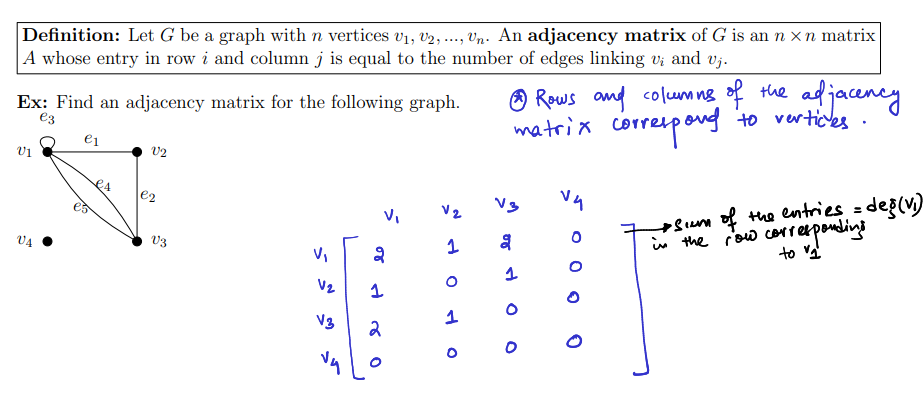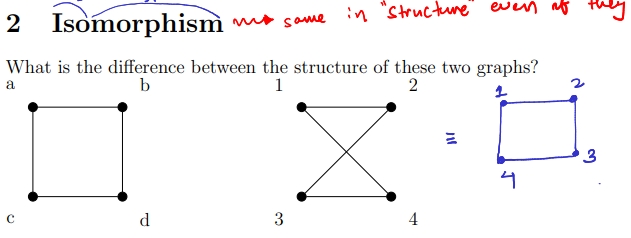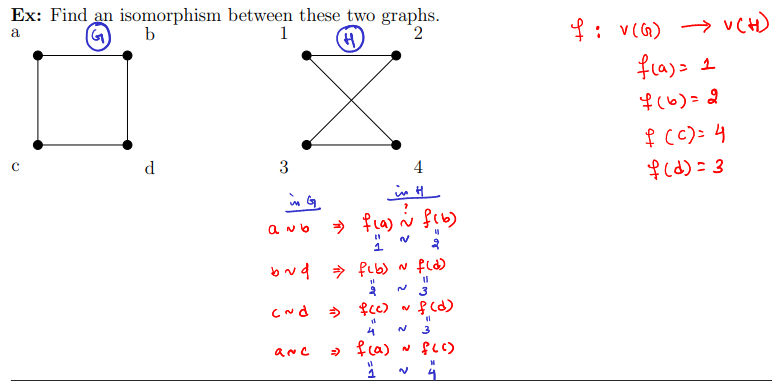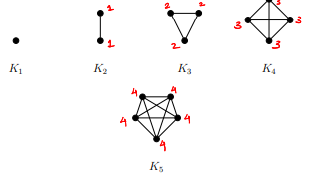Graph Theory
1/28
There's no tags or description
Looks like no tags are added yet.
Name | Mastery | Learn | Test | Matching | Spaced |
|---|
No study sessions yet.
29 Terms
EXAMPLE OF A GRAPH

defn of a graph
a graph G is a pair (V(G), E(G))
V(G)
is a set
elements of V(G) are the vertices of graph G
E(G)
is a set
elements of E(G) are the edges of the graph G
the sets V(G) and E(G) are linked by an
incidence function (see image)
“e1 is incident to v1” if an end of e1 is connected to v1

defn of a loop
An edge e ∈ E(G) is a loop if ψG(e) = {v} for some vertex v ∈ V (G).
→ meaning both ends of the edge connects to the same vertex
defn of arc
An edge e ∈ E(G) is an arc if ψG(e) = {u, v}, for two distinct vertices u, v ∈ V (G).
meaning an edge connecting two vertices together
parallel
Two edges e1 and e2 are parallel if ψG(e1) = ψG(e2)
two edges connect together the same two vertices
defn of a simple graph
A graph is simple if it has no loops and no parallel edges.
adjacents
Two vertices u, v ∈ V(G) are adjacents (or neighbours) if there is an edge e ∈ E(G) such that ψG(e) = {u, v}. In this case, we write u ∼ v.
meaning the vertices are connected by the same edge
An edge e ∈ E(G) is said to be ___________ to the vertices of ψG(e).
incident
adjacency matrix defn
Let G be a graph with n vertices v1, v2, ..., vn.
An adjacency matrix of G is an n×n matrix A whose entry in row i and column j is equal to the number of edges linking vi and vj.
see image for example
note: there’s a 2 for entry (v1,v1) since both ends of e3 connects to v1

defn of a degree
Let G be a graph. The degree of a vertex v ∈ V(G), denoted by deg(v), is the number of edges incident to v, where loops on v are counted twice.
degree sequence
If V(G) = {v1, v2, ..., vn}, then the degree sequence of G is
(deg(v1), deg(v2), ..., deg(vn))
the nums in a deg sequence can be in ANY ORDER
Handshake Lemma (formula)

degree sequences are _______ to one graph
NOT unique; multiple graphs can have the same deg sequence
isomorphism concept

defn of isomorphism
Let G and H be two simple graphs. An isomorphism from G to H is a bijective function f : V (G) → V (H) such that for all u, v ∈ V (G), we have
u ∼ v ↔ f(u) ∼ f(v)
→ meaning adjacency properties are preserved
isomorphism basic example

to show that two graphs are isomorphic
present an isomorphism between the two graphs
show the bijective fn
show the graph diagram
to show that two graphs G and H CANNOT be isomorphic
you must find a FUNDAMENTAL DIFFERENCE between G and H
the difference could be (verify in this order):
diff num of vertices
diff num of edges
diff deg sequence / diff num of elements in deg sequence
a subgraph of G that isn’t a subgraph of H
defn of a subgraph
Let G and H be two graphs. We say that H is a subgraph of G if V (H) ⊆ V (G) and E(H) ⊆ E(G). In this case, we write H ⊆ G
the set of vertices of H is a subset of the set of vertices of G
AND the set of edges of H is a subset of the set of edges of G
subgraphs visual

defn of a complete graph
let n be a positive integer (a natural num). the complete graph on n vertices, denoted by Kn, has the following properties:
Kn is simple, |V(Kn)| = n → |V(K2)| = 2, meaning the graph of K2 has 2 vertices
each pair of vertices is linked by one edge.
every vertice is linked to every other vertice in the graph

how many edges does a complete graph Kn have?
n “choose” 2
what is the deg sequence for a complete graph Kn?
(n-1, n-1, n-1, ….., n-1) → n - 1 repeated n times (since a complete graph of Kn has n vertices)
defn of a cycle
let n be a positive integer.
a cycle of length n, denoted by Cn, is the following graph:
V(Cn) = {u1, u2, ..., un}. The vertex u1 is adjacent to u2 and to un.
The vertex un (the “last” vertice in the set of vertcies) is adjacent to un−1 and to u1 (the first vertice).
For every other vertex, ui is adjacent to ui−1 and to ui+1.
how many edges does a cycle graph Cn have?
n
could think of a shape having the same number “sides” as vertices
what is the deg sequence of a cycle graph Cn?
(2, 2, 2, 2…..2) → repeated n times since a graph Cn has vertices